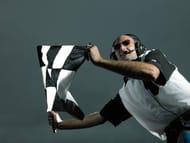#2 Flags
You’ve probably seen marshals waving flags during the race. Everyone is familiar with the chequered flag at the end – but what about all of the other flags? Here’s a lowdown:

Chequered flags: everyone knows these. They signal the end of the race, waved at the winner and all subsequent cars when they cross the finish line.
Red flags: These are quite intuitive, indicating the stoppage or end of the racing session. This is usually done due to impossible racing conditions or if an accident has occured on the track.
Yellow flags: These, as mentioned earlier, are usually brought out to indicate safety cars, and to tell drivers to slow down. Overtaking is prohibited, and if two yellow flags are waved at once, this means cars must slow down, or potentially come to a halt.
Green flags: Brought out after yellow flags, when restrictions on speed and/or overtaking which were imposed by those flags are stopped. The race may now continue as before.
Yellow and red striped flag: This is to warn of a slick, slippery surface. Usually brought out in rainy conditions, or if there is oil spillage on the track. May be spotted at the Red Bull Ring!
Blue flags: To warn a driver that he is about to be lapped by another car, telling him to give way. A failure to comply with these flags three times in a row will cause the driver to receive a penalty. They are also waved when a car is about to enter the pit lane.
Half-white, half-black: Warns against what the FIA describes as “unsporting” behaviour, this flag is always displayed with a specific car number. Failure to comply may lead to a black flag.
Black flag: Used to tell a driver that he may no longer continue in the race. Like the half-white half-black flag, this is also accompanied by the relevant driver’s car number.
